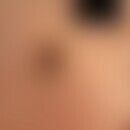Synonym(s)
HistoryThis section has been translated automatically.
DefinitionThis section has been translated automatically.
Carcinoma in situ of the genital mucous membrane; mucous membrane variant of Bowen's disease. Occurs primarily in uncircumcised men. The term erythroplasia is no longer undisputed; some authors want to leave it in favour of the term anogenital "carcinoma in situ" or "penile intraepithelial neoplasia" (see PIN below).
You might also be interested in
ManifestationThis section has been translated automatically.
Occurs mainly in men > 60 years. Rarely in circumcised men.
LocalizationThis section has been translated automatically.
Clinical featuresThis section has been translated automatically.
Bright red, 0.5-2.0 cm large, sharply defined, velvety grained, or surface smooth, shiny, slightly indurated, less symptomatic plaques. Patients with changes reminiscent of "bowenoid papulosis" may have several clearly raised, red or reddish-brown papules. Especially in the coloured population, all lesions may be characterised by pigmentation of varying intensity.
HistologyThis section has been translated automatically.
Carcinomatous epithelial remodelling with cell atypia, giant cells. Mitoses are abundantly found in all, not only the basal epithelial sections. A graduation of dysplasia in 3 stages can be performed depending on the extent of the dysplasia (see PIN below). No infiltrative growth detectable.
Differential diagnosisThis section has been translated automatically.
Complication(s)This section has been translated automatically.
Transition to invasive penile carcinoma.
TherapyThis section has been translated automatically.
- Early excision in healthy individuals is the therapy of choice, since only this guarantees control of the incision edges. In the case of frequent localisation at the glans penis, the subsequent covering of the defect with the help of the outer foreskin leaf (according to Happle) or the inner foreskin leaf (according to Kaufmann) should be aimed for.
- Alternatively,CO2 laser, ablation with an electrical snare, cryosurgery, soft X-rays can be considered. The prognosis is less favourable than for Bowen's disease, therefore patients should be checked regularly over several years.
- The efficacy of topical application (off-label use) of 1% cidofovir cream(37.5 mg Vistide in 3.25 g base cream) 5 times/week for 2 weeks and 5% imiquimod (Aldara) 3 times/week for up to 16 weeks (off-label use) is described in individual case reports.
Note(s)This section has been translated automatically.
More rare are clearly infiltrated, differently sized, verrucous plaques with a whitish macerated, wart-like surface. However, such findings do not correspond to the definition of Queyrat's erythroplasia and should then be described as "verrucous carcinoma in situ of the penis".
LiteratureThis section has been translated automatically.
- Arlette JP (2003) Treatment of Bowen's disease and erythroplasia of Queyrat. Br J Dermatol 149:(Suppl 66): 43-49
- Calista D (2002) Topical cidofovir for erythroplasia of Queyrat of the glans penis. Br J Dermatol 147: 399-400
- Davis-Daneshfar A et al (2000) Bowen's disease of the glans penis (erythroplasia of Queyrat) in plasma cell balanitis. Cutis 65: 395-398
- Gross G, Pfister H (2004) Role of human papillomavirus in penile cancer, penile intraepithelial squamous cell neoplasias and in genital warts. Med Microbiol Immunol (Berl) 193: 35-44
- Porter WM et al (2002) Penile intraepithelial neoplasia: clinical spectrum and treatment of 35 cases. Br J Dermatol 147: 1159-1165
- Queyrat LE (1911) Erythroplasia du gland. Bull Soc Fr Dermatol Syph 22: 378-382
- Schmitz L et al (2014) Optical coherence tomography imaging of erythroplasia of Queyrat and treatment with imiquimod 5% cream: a case report. Dermatology 228:24-26
Stables GI et al (1999) Erythroplasia of Queyrat treated by topical aminolaevulinic acid photodynamic therapy. Br J Dermatol 140: 514-517
- van Bezooijen BP et al (2001) Laser therapy for carcinoma in situ of the penis. J Urol 166: 1670-1671
Incoming links (16)
Acuminate condyloma; Balanitis psoriatica; Bowenoids papulose; Bowen's disease; Candida balanitis; Carcinoma in situ; Cheilitis plasmacellularis; Cryosurgery; Epithelioma, nude papillary; Epithélioma papillaire nu; ... Show allOutgoing links (12)
Balanitis plasmacellularis; Bowen's disease; Cidofovir; Cryosurgery; Drug reaction fixe; Excision; Imiquimod; Lichen planus classic type; Penile carcinoma; Pin; ... Show allDisclaimer
Please ask your physician for a reliable diagnosis. This website is only meant as a reference.













